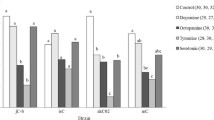Abstract
It is now generally recognized that it is necessary to examine how sexual selection operates across the lifespan of a male, in order to understand the total sexual selection in action. However, less attention has been paid to the fact that selection pressures can change in response to varying environmental conditions. Here, we examine male allocation to trait subject to pre- and post-copulatory sexual selection in Callosobruchus chinensis. We find evidence of a trade-off between dispersal ability and testes size and sperm transfer, across geographical strains. In addition, male mating success of strains with larger testes and better dispersal ability, respectively, changed in response to environmental conditions. Males with better dispersal ability had greater success in securing mates, compared to males with larger testes, under conditions where it was harder to find females. There was no difference in male ability to secure mates when it was easy for them to find females. However, we suggest that males with larger testes are likely to have an advantage in sperm competition under conditions where it is easier to find females, and when females are thus likely to mate multiply. Our results indicate that environmental fluctuations and trade-offs can work in conjunction to maintain alternative male behavioral reproductive strategies.




Similar content being viewed by others
References
Andersson M (1994) Sexual selection. Princeton University Press, Princeton
Birkhead TR, Møller AP (1998) Sperm competition and sexual selection. Academic Press, New York
Colgoni A, Vasimo SM (2006) Sexual dimorphism and allometry in two seed beetles (Coleoptera: Bruchidae). Entomol Sci 9:171–179
Cornwallis CK, Uller T (2010) Towards an evolutionary ecology of sexual traits. Trends Ecol Evol 25:145–152
Gross MR (1996) Alternative reproductive strategies and tactics: diversity within sexes. Trends Ecol Evol 11:92–98
Hunt J, Breuker CJ, Sadowski JA, Moore AJ (2009) Male-male competition, female mate choice and their interaction: determing total sexual selection. J Evol Biol 22:13–26
Kokko H, Rankin DJ (2006) Lonely hearts or sex in the city? Density-dependent effects in mating systems. Philos Trans R Soc B 361:319–334
Miller CW, Svensson EI (2014) Sexual selection in complex environments. Annu Rev Entomol 59:427–445
Moore AJ, Moore PJ (1999) Balancing sexual selection through opposing mate choice and male competition. Proc R Soc Lond B 266:711–716
Ohno T, Miyatake T (2007) Drop or fly? Negative genetic correlation between death-feigning intensity and flying ability as alternative anti-predator strategies. Proc R Soc Lond B 274:555–560
Okada K, Nomura Y, Miyatake T (2007) Relations between allometry, male-male interactions and dispersal in a sap beetle, Librodor japonicus. Anim Behav 74:749–755
Parker GA (1990) Sperm competition games: raffles and roles. Proc R Soc Lond B 242:120–126
Parker GA, Ball MA (2005) Sperm competition, mating rate and the evolution of testis and ejaculate sizes: a population model. Biol Lett 1:235–238
Pitcher TE, Doucet SM, Beausoleil JMJ, Hanley D (2009) Secondary sexual characters and sperm traits in coho salmon Oncorhynchus kisutch. J Fish Biol 74:1450–1461
Pomfret JC, Knell RJ (2008) Crowding, sex ratio and horn evolution in a South African beetle community. Proc R Soc Lond B 275:315–321
Reznick D, Nunney L, Tessier A (2000) Big house, big cars, superfleas and the costs of reproduction. Trends Ecol Evol 15:421–425
Roff DA (2002) Life history evolution. Sunderland, Massachusetts, Sinauer Associates
SAS Institute (2013) JMP release 11. SAS Institute Inc., Cary, NC
Sbilordo SH, Martin OY (2014) Pre- and post-copulatory sexual selection act in concert to determine male reproductive success in Tribolium castaneum. Biol J Linn Soc 112:67–75
Shinoda K, Yoshida T (1984) Relationship between adult feeding and emigration from beans of adzuki bean weevil, Callosobruchus chinensis Linne (Coleoptera: Bruchidae). Appl Entomol Zool 19:202–211
Shinoda WK, Yoshida T (1985) Field biology of the azuki bean weevil, Callosobruchus chinensis (L.)(Coleoptera: Bruchidae). I. Seasonal prevalence and assessment of field infestation of Aki-Azuki, an autumn variety of Phaseolus angularis. Jpn J Appl Entomol Zool 29:14–20
Shinoda K, Yoshida T (1990) Life history of the Azuki Bean Weevil, Callosobruchus chinensis L.,(Coleoptera: Bruchidae), in the field. In: Bruchids and legumes: economics, ecology and coevolution. Springer, Netherlands, pp 149–159
Shuster SM, Wade MJ (2003) Mating system and strategies. Princeton University Press, New Jersey
Simmons LW, Emlen DJ (2006) Evolutionary trade-off between weapons and testes. Proc Natl Acad Sci U S A 103:16346–16351
Utida T (1943) Studies on the experimental population of the azuki bean weevil, Callosobruchus chinensis (L.). VIII. Statistical analysis of the frequency distribution of the emerging weevils on beans. Mem Coll Agr Kyoto Imp Univ 54:22
Wickman P-O, Rutowski RL (1999) The evolution of mating dispersal in insects. Oikos 84:463–472
Yamane T, Miyatake T (2005) Intra-specific variation in strategic ejaculation according to level of polyandry in Callosobruchus chinensis. J Insect Physiol 51:1240–1243
Yamane T, Miyatake T (2008) Strategic ejaculation and level of polyandry in Callosobruchus chinensis (Coleoptera: Bruchidae). J Ethol 26:225–231
Yamane T, Okada K, Nakayama S, Miyatake T (2010) Dispersal and ejaculate strategies associated with exaggeration of weapon in an armed beetle. Proc R Soc B 77:1705–1710
Acknowledgments
We thank Dr. T. Yamane for providing the technique to estimate sperm transfer, and Dr. K. Okada and Dr. T. Harano for providing valuable comments on the manuscript. We also thank two anonymous reviewers for their valuable comments. This work was supported by Japan Society for the Promotion of Science (Grants-in-Aid for JSPS Fellows 224565 and 251662).
Author information
Authors and Affiliations
Corresponding author
Additional information
Communicated by N. Wedell
Rights and permissions
About this article
Cite this article
Katsuki, M., Lewis, Z. A trade-off between pre- and post-copulatory sexual selection in a bean beetle. Behav Ecol Sociobiol 69, 1597–1602 (2015). https://doi.org/10.1007/s00265-015-1971-4
Received:
Revised:
Accepted:
Published:
Issue Date:
DOI: https://doi.org/10.1007/s00265-015-1971-4




